About Iruppu Falls
The Irupu Falls (also Iruppu Falls) According to popular legend, Rama and Lakshmana, passed along the Bhramagiri range whilst searching for Rama’s beloved, Sita. When Rama asked Lakshmana to fetch him drinking water, Lakshmana shot an arrow into the Brahmagiri hills and brought into being the river Lakshmana Tirtha.Due to this legend, the Falls is believed to possess the power to cleanse sins and is visited by thousands of devotees on Shivaratri day.
About Nagarhole
Nagarhole Originally the forest area was the private hunting ground for the Maharajas of Mysore. Nagarhole was converted into a sanctuary in the year 1955 covering an area of 258 sq. km and subsequently enlarged to include the adjoining areas of Mysore district and now extends over an area of 643 sq. km. Nagarhole got National Park status in 1988 and declared as 37th Project Tiger Reserve in 1999. It is part of the Nilgiri Biosphere Reserve. The Western Ghats Nilgiri sub-cluster of 6,000 Sq. km, including all of Nagarhole National Park, is under consideration by the UNESCO World Heritage for World Heritage Site status.
DAY 1 PICKUP FROM MYSORE: Hotel /Airport / Railway Station / Bus Station and proceed to Iruppu Falls & Nagarhole Local Sightseeing places including:
IRUPPU FALLS
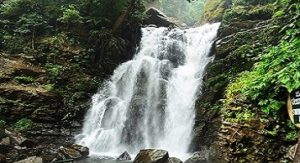 Dropping from a height of 170 feet through several stages, the falls are situated amidst thick forest of Western Ghats. The roaring waters of the Irupu Falls and the picturesque surroundings make it a favorite picnic spot. It is an unforgettable experience to stand at bottom of the cascades and play in the sizzling waters of the falls. Iruppu Falls is a part of the Brahmagiri forest range, there is a trek route that leads to the Narimale forest camp and then on to Brahmagiri Peak. Permission from forest department is needed for doing this trek.
Dropping from a height of 170 feet through several stages, the falls are situated amidst thick forest of Western Ghats. The roaring waters of the Irupu Falls and the picturesque surroundings make it a favorite picnic spot. It is an unforgettable experience to stand at bottom of the cascades and play in the sizzling waters of the falls. Iruppu Falls is a part of the Brahmagiri forest range, there is a trek route that leads to the Narimale forest camp and then on to Brahmagiri Peak. Permission from forest department is needed for doing this trek.
NAGARHOLE NATIONAL PARK
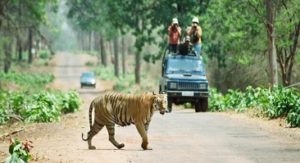 The important animals in Nagarhole National Park are tiger, leopard, wild dog, sloth bear, the hyena, spotted deer, sambar, barking deer, four-horned antelope, gaur, wild boar and elephant. Among reptiles, the marsh crocodile, monitor lizard, rock python and several other species are represented. Other mammals includes the common langur, bonnet macaque, jungle cat, slender loris, leopard-cat, civet cat, mongoose, common otter, giant flying squirrel, giant squirrel, porcupine, jackal, mouse-deer, hare and pangolin. Over 250 species of birds are found at Nagarhole National Park.
The important animals in Nagarhole National Park are tiger, leopard, wild dog, sloth bear, the hyena, spotted deer, sambar, barking deer, four-horned antelope, gaur, wild boar and elephant. Among reptiles, the marsh crocodile, monitor lizard, rock python and several other species are represented. Other mammals includes the common langur, bonnet macaque, jungle cat, slender loris, leopard-cat, civet cat, mongoose, common otter, giant flying squirrel, giant squirrel, porcupine, jackal, mouse-deer, hare and pangolin. Over 250 species of birds are found at Nagarhole National Park.
Drop at Mysore Hotel / Over Night Stay In Mysore End of a One Day Iruppu Falls & Nagarhole Local Sightseeing Tour…
Itinerary for Day 2 Shivanasamudra Falls – Somnathpur – Talakadu & Mudukuthore Tempel Sigtseeing Tour
About Shivavanasamudra Falls
The Shivanasamudra Falls is on the Kaveri River after the river has found its way through the rocks and ravines of the Deccan Plateau and drops off to form waterfalls.The island town of Shivanasamudra divides the river into twin waterfalls. This creates the fourth largest island in the rivers course. A group of ancient temples are located here and there likely was a village.
About Somnathpur
Somnathpur is a home to the popular Keshava temple built during the reign of Hoysala emperors. The temple stands erect as a symbol of great authority and skills possessed by Hoysala rulers. The sculpture and the idols of God and Goddesses speak volume about the Hoysala kingdom. This temple has won the recognition of a heritage site and is taken care by Archeological Survey of India.
About Talakadu
The origin of the town is lost in antiquity; but one tradition is that its name was derived from two Kirata twin brothers, Tala and Kadu, who, cutting down a tree which they saw wild elephants worshiping, discovered that it contained an image of shiva, and that the elephants were rishis transformed. The tree being miraculously restored, all obtained moksha and the place was named Tala-kadu, which was translated into Sanskrit as Dala-vana. Two stone images declared to represent the brothers are pointed out in front of the temple Veerabadra swamy. In a later age, Rama is said to have halted here on his expedition to Lanka.
About Mudukuthore
The Mudukuthore Mallikarjuna Temple is one of the Panchalinga Darshana Temples in and around Talakad. The other temples are Sri Kshetra Vaideshwara, Sri Pathaleshwara, Sri Maruleshwara, and Sri Arakeshwara. Along with Sri Mudukuthore Mallikarjuneshwara, they form the five Shiva Lingas of the Panchalinga Darshana.The Panchalinga Darshana usually takes place once every 12 years. The exact date is based on astrological calculation. The festival starts simultaneously in all five temples. Mudukuthore is also famous for the week-long agricultural fair held here every year during January and February.
DAY 2 PICKUP FROM MYSORE: Hotel / After Brakefast and proceed Shivanasamudra Falls – Somnathpur – Talakadu & Mudukuthore Tempel Sightseeing places including:
SHIVANASAMUDRA FALLS
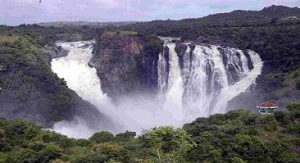 The Shivanasamudra Falls is on the Kaveri River after the river has found its way through the rocks and ravines of the Deccan Plateau and drops off to form waterfalls.[2] The island town of Shivanasamudra divides the river into twin waterfalls. This creates the fourth largest island in the rivers course. A group of ancient temples are located here and there likely was a village.This is a segmented waterfall. Segmented waterfalls occur where the water flow is broken into two or more channels before dropping over a cliff, resulting in multiple side by side waterfalls. It has an average width of 305 meters (1,001 ft), a height of 98 m (322 ft), and an average volume of 934 cubic metres per second (33,000 cu ft/s). The maximum recorded volume is 18,887 cubic metres per second (667,000 cu ft/s).
The Shivanasamudra Falls is on the Kaveri River after the river has found its way through the rocks and ravines of the Deccan Plateau and drops off to form waterfalls.[2] The island town of Shivanasamudra divides the river into twin waterfalls. This creates the fourth largest island in the rivers course. A group of ancient temples are located here and there likely was a village.This is a segmented waterfall. Segmented waterfalls occur where the water flow is broken into two or more channels before dropping over a cliff, resulting in multiple side by side waterfalls. It has an average width of 305 meters (1,001 ft), a height of 98 m (322 ft), and an average volume of 934 cubic metres per second (33,000 cu ft/s). The maximum recorded volume is 18,887 cubic metres per second (667,000 cu ft/s).
SOMANATHPUR TEMPLE
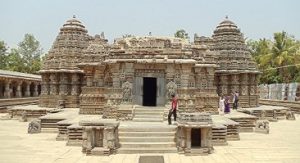 The Chennakesava Temple, also referred to as Chennakeshava Temple, Keshava Temple or Kesava Temple, is a Vaishnava Hindu temple on the banks of River Kaveri at Somanathapura, Karnataka, India. The temple was consecrated in 1258 CE by Somanatha Dandanayaka, a general of the Hoysala King Narasimha III. It is located 38 kilometres (24 mi) east of Mysuru city.The Somanathapura town was founded in the 13th century by a general named Somanatha (Someya Dandanayaka in some inscriptions). He was working for the Hoysala King Narasimha III.Somanatha created an Agrahara, that is granted land to Brahmins and dedicated resources to build and maintain temples therein.[The town (pura) became known after the name of the patron, Somanatha-pura. The location is also referred by alternate spellings, such as Somnathpur.
The Chennakesava Temple, also referred to as Chennakeshava Temple, Keshava Temple or Kesava Temple, is a Vaishnava Hindu temple on the banks of River Kaveri at Somanathapura, Karnataka, India. The temple was consecrated in 1258 CE by Somanatha Dandanayaka, a general of the Hoysala King Narasimha III. It is located 38 kilometres (24 mi) east of Mysuru city.The Somanathapura town was founded in the 13th century by a general named Somanatha (Someya Dandanayaka in some inscriptions). He was working for the Hoysala King Narasimha III.Somanatha created an Agrahara, that is granted land to Brahmins and dedicated resources to build and maintain temples therein.[The town (pura) became known after the name of the patron, Somanatha-pura. The location is also referred by alternate spellings, such as Somnathpur.
TALAKADU TEMPLE
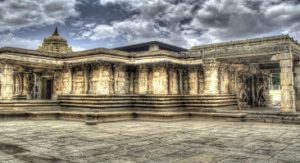 Talakad is also tagged with the curse called “Curse of Talakad” by Alamelamma on the Wodeyars of Mysore.Raja Wadiyar sent his soldiers to Talakadu. Alamelamma assumed the king’s men had come to capture her and make her a slave. She tried to escape to T Narasipura. She found no way to escape from the soldiers but to jump into Malangi River. Legend says that when the king’ soldiers tried to get at the fleeing Alamelamma, they got her hair before she disappeared into the water.At that moment she cursed “Talakadu managali, Malangi madwagali, Mysooru arasarige makkalu aagadirali” which translates to “May Malangi turn into an unfathomed whirlpool, Talakad turn into a barren expanse of sand and the Rajas of Wadiyar not beget male heir”. Till today whatever she has said stands true.
Talakad is also tagged with the curse called “Curse of Talakad” by Alamelamma on the Wodeyars of Mysore.Raja Wadiyar sent his soldiers to Talakadu. Alamelamma assumed the king’s men had come to capture her and make her a slave. She tried to escape to T Narasipura. She found no way to escape from the soldiers but to jump into Malangi River. Legend says that when the king’ soldiers tried to get at the fleeing Alamelamma, they got her hair before she disappeared into the water.At that moment she cursed “Talakadu managali, Malangi madwagali, Mysooru arasarige makkalu aagadirali” which translates to “May Malangi turn into an unfathomed whirlpool, Talakad turn into a barren expanse of sand and the Rajas of Wadiyar not beget male heir”. Till today whatever she has said stands true.
MUDUKUTHORE TEMPLE
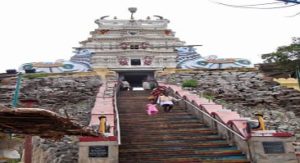 Mudukuthore (Thirumalakudu Bettahalli) is a pilgrim centre situated on the banks of the river Kaveri. The village is called T. Bettahalli, as per the government revenue documents, whereas Mudukuthore is a mythological name. T. Bettahalli is a quiet village with a backdrop of a hillock called Somagiri.T Bettahalli is located at a distance of 48 km from Mysore, 25 km from Somanathapura, 18 km from T.Narsipur, and is close to Talakad.The place is known for the temple of Lord Mallikarjuna. During January-February, every year, a big festival fair is organized for a week where cattle and agricultural products are traded. This famous fair attracts thousands of visitors.
Mudukuthore (Thirumalakudu Bettahalli) is a pilgrim centre situated on the banks of the river Kaveri. The village is called T. Bettahalli, as per the government revenue documents, whereas Mudukuthore is a mythological name. T. Bettahalli is a quiet village with a backdrop of a hillock called Somagiri.T Bettahalli is located at a distance of 48 km from Mysore, 25 km from Somanathapura, 18 km from T.Narsipur, and is close to Talakad.The place is known for the temple of Lord Mallikarjuna. During January-February, every year, a big festival fair is organized for a week where cattle and agricultural products are traded. This famous fair attracts thousands of visitors.
Drop at Mysore Hotel / Over Night Stay In Mysore End of a Day 2 Shivanasamudra Falls – Somnathpur – Talakadu & Mudukuthore Tempel Local Sightseeing Tour…
Itinerary for Day 1 Mysore Local Sigtseeing Tour Package
About Mysore
Mysore or Mysuru, is the third largest city in Karnataka. The city was ruled by the Wodeyar dynasty and it is well known for the rich architectural history, palaces, and beautiful gardens. It is located at the bottom of the Chamundi Hills and is about 150 kms from Bangalore.The city has a large tourism industry, which attracts tourists from all across the World. The city is famous for the palaces, the delicious Pak and the Dashara celebration in the city. It is one of the most visited destinations in Karnataka.
DAY 3 PICKUP FROM MYSORE: Hotel / After Brakefast and proceed Mysore Sightseeing places including:
CHAMUNDI HILL TEMPLE
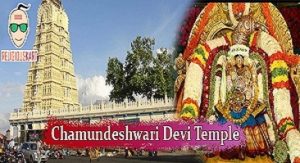 Located at the top of Chamundi Hills, Chamundeshwari temple is one of most prominent temples in Mysore. Dedicated to the Goddess Chamundeshwari (Chamundi), deity of the Mysore Royal Family and Mysore as well, this temple is about 1000 steps from the foot of the hill. The goddess is seated on a lion, killing the demon with her ‘trishul’. With its impressive architecture, great historical significance and surrounded with nature’s serenity at the Chamundi hills, this temple is still known as a prominent temples in India, attracting not only devotees but tourists from everywhere who come to witness its unshakable grandeur.
Located at the top of Chamundi Hills, Chamundeshwari temple is one of most prominent temples in Mysore. Dedicated to the Goddess Chamundeshwari (Chamundi), deity of the Mysore Royal Family and Mysore as well, this temple is about 1000 steps from the foot of the hill. The goddess is seated on a lion, killing the demon with her ‘trishul’. With its impressive architecture, great historical significance and surrounded with nature’s serenity at the Chamundi hills, this temple is still known as a prominent temples in India, attracting not only devotees but tourists from everywhere who come to witness its unshakable grandeur.
SAND MUSEUM
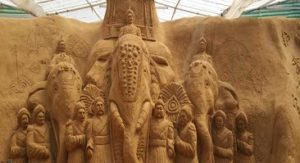 Sand sculpture Museum displays around 150 sculptures of sand in 16 different themes, which have been placed over an area of 13500 sq. feet. These sand sculptures have been created using more than 115 truckloads of sand. Various interesting themes have been used at the museum ranging from mysore heritage, wildlife, culture, instances from different religious epics and fairy tales and stories.At the entrance of the museum, tourists will see a statue of Lord Ganesha, which has a height of 15 feet. Other sand sculptures at the museum are of Goddess Chamundeshwari, erstwhile Mysore King Srikanta Datta Narasimharaja Wadiyar who is shown seated on his throne during a Dasara festival, Lord Krishna and Arjuna on a horse-drawn chariot, Laughing Buddha, Christmas tree and Santa Claus, Disneyland, ancient Egypt, zodiac wheel, instances from Arabian nights, Tom & Jerry cartoon, etc.
Sand sculpture Museum displays around 150 sculptures of sand in 16 different themes, which have been placed over an area of 13500 sq. feet. These sand sculptures have been created using more than 115 truckloads of sand. Various interesting themes have been used at the museum ranging from mysore heritage, wildlife, culture, instances from different religious epics and fairy tales and stories.At the entrance of the museum, tourists will see a statue of Lord Ganesha, which has a height of 15 feet. Other sand sculptures at the museum are of Goddess Chamundeshwari, erstwhile Mysore King Srikanta Datta Narasimharaja Wadiyar who is shown seated on his throne during a Dasara festival, Lord Krishna and Arjuna on a horse-drawn chariot, Laughing Buddha, Christmas tree and Santa Claus, Disneyland, ancient Egypt, zodiac wheel, instances from Arabian nights, Tom & Jerry cartoon, etc.
WAX MUSEUM
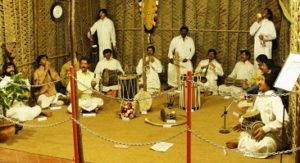 The Wax Museum, also popular as Melody Wax Museum, boasts of 19 galleries and more than 300 musical instruments, showcased in various bands including Indian classical, Hip Hop, Jazz, Punjabi Bhangra and Rock. Created by an IT professional, Shreeji Bhaskaran in 2010 and set up in a 90 year old building, the museum is worth a visit.Conceptualized and developed by the collective efforts of both Shreeji Bhaskaran and his wife Reena, the museum is a tribute to all the honoured musicians across the world. Visitors interested in music will be elated to rub their shoulders with the life-size wax statues playing varied musical instruments.
The Wax Museum, also popular as Melody Wax Museum, boasts of 19 galleries and more than 300 musical instruments, showcased in various bands including Indian classical, Hip Hop, Jazz, Punjabi Bhangra and Rock. Created by an IT professional, Shreeji Bhaskaran in 2010 and set up in a 90 year old building, the museum is worth a visit.Conceptualized and developed by the collective efforts of both Shreeji Bhaskaran and his wife Reena, the museum is a tribute to all the honoured musicians across the world. Visitors interested in music will be elated to rub their shoulders with the life-size wax statues playing varied musical instruments.
KARANJI LAKE
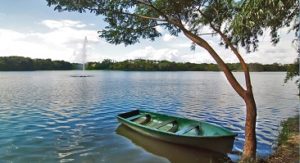 Karanji Lake is a lake located in the city of Mysore in the state of Karnataka, India. The lake is surrounded by a nature park consisting of a butterfly park and a walk-through aviary. This aviary is the biggest ‘walk-through aviary’ in India. There is also a museum, the Regional Museum of Natural History which is located on the banks of this lake. The total area of Karanji lake is 90 hectares. While waterspread area is about 55 hectares, the foreshore area measures about 35 hectares. Karanji lake is owned by the Mysore Zoo Authority. Mysore Zoo gets a revenue of an average of Rs. 50000 per day from ticket sales to enthusiasts who visit this lake.
Karanji Lake is a lake located in the city of Mysore in the state of Karnataka, India. The lake is surrounded by a nature park consisting of a butterfly park and a walk-through aviary. This aviary is the biggest ‘walk-through aviary’ in India. There is also a museum, the Regional Museum of Natural History which is located on the banks of this lake. The total area of Karanji lake is 90 hectares. While waterspread area is about 55 hectares, the foreshore area measures about 35 hectares. Karanji lake is owned by the Mysore Zoo Authority. Mysore Zoo gets a revenue of an average of Rs. 50000 per day from ticket sales to enthusiasts who visit this lake.
MYSORE ZOO
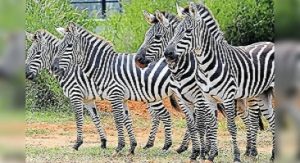 Mysore Zoo (Now Mysuru Zoo) (officially the Sri Chamarajendra Zoological Gardens) is a 157-acre (64 ha) zoo located near the palace in Mysore, India. It is one of the oldest and most popular zoos in India, and is home to a wide range of species (168). Mysore Zoo is one of the city’s most popular attractions.While mainly depending on entry fees for its financing, an adoption scheme introduced in the early 2000s has been a success. Celebrities, institutions,animal lovers and Volunteers of various clubs in the zoo have contributed directly to the welfare of the zoo inmates.
Mysore Zoo (Now Mysuru Zoo) (officially the Sri Chamarajendra Zoological Gardens) is a 157-acre (64 ha) zoo located near the palace in Mysore, India. It is one of the oldest and most popular zoos in India, and is home to a wide range of species (168). Mysore Zoo is one of the city’s most popular attractions.While mainly depending on entry fees for its financing, an adoption scheme introduced in the early 2000s has been a success. Celebrities, institutions,animal lovers and Volunteers of various clubs in the zoo have contributed directly to the welfare of the zoo inmates.
MYSORE PALACE
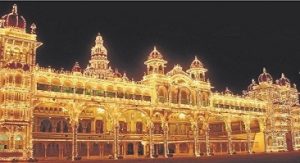 Ambavilas Palace otherwise known as the Mysore Palace is a historical palace and a royal residence at Mysore in the Indian State of Karnataka. It is the official residence of the Wadiyar dynasty and the seat of the Kingdom of Mysore. The palace is in the centre of Mysore, and faces the Chamundi Hills eastward. Mysore is commonly described as the ‘City of Palaces’, and there are seven palaces including this one; however, ‘Mysore Palace’ refers specifically to this one within the Old Fort.The land on which the palace now stands was originally known as puragiri (literally, citadel), and is now known as the Old Fort. Yaduraya built the first palace inside the Old Fort in the 14th century, which was demolished and constructed multiple times. The current structure was constructed between 1897 and 1912, after the Old Palace was burnt ablaze.Mysore Palace is now one of the most famous tourist attractions in India, after the Taj Mahal, with more than 6 million annual visitors.
Ambavilas Palace otherwise known as the Mysore Palace is a historical palace and a royal residence at Mysore in the Indian State of Karnataka. It is the official residence of the Wadiyar dynasty and the seat of the Kingdom of Mysore. The palace is in the centre of Mysore, and faces the Chamundi Hills eastward. Mysore is commonly described as the ‘City of Palaces’, and there are seven palaces including this one; however, ‘Mysore Palace’ refers specifically to this one within the Old Fort.The land on which the palace now stands was originally known as puragiri (literally, citadel), and is now known as the Old Fort. Yaduraya built the first palace inside the Old Fort in the 14th century, which was demolished and constructed multiple times. The current structure was constructed between 1897 and 1912, after the Old Palace was burnt ablaze.Mysore Palace is now one of the most famous tourist attractions in India, after the Taj Mahal, with more than 6 million annual visitors.
JAGAN MOHAN PALACE / JAYACHAMARAJENDRA ART GALLERY
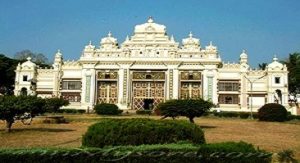 Jaganmohan Palace is a palace in Mysore, in the princely city of Mysore, India. Its construction was completed in 1861 and was initially used by the Wodeyars,Kings Of Mysore as their home (when the present majestic Mysore Palace (Amba Vilas Palace) was under construction after the old palace turned into ashes owing to a fire accident). It is now converted into an art gallery and a function hall. The palace is one of the seven palaces of the royal city of Mysore and one of the most beautiful contributions of the Wodeyar Kings of the city during their regime. The royal family has innumerable contributions not only to Mysore but also to some of the most important present metropolitans like Bangalore.
Jaganmohan Palace is a palace in Mysore, in the princely city of Mysore, India. Its construction was completed in 1861 and was initially used by the Wodeyars,Kings Of Mysore as their home (when the present majestic Mysore Palace (Amba Vilas Palace) was under construction after the old palace turned into ashes owing to a fire accident). It is now converted into an art gallery and a function hall. The palace is one of the seven palaces of the royal city of Mysore and one of the most beautiful contributions of the Wodeyar Kings of the city during their regime. The royal family has innumerable contributions not only to Mysore but also to some of the most important present metropolitans like Bangalore.
ST. PHILOMENA’S CATHEDRAL
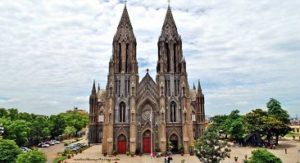 The church is dedicated to 3rd century saint Philomena who was the daughter of the monarch of a small state in Greece. Her parents were childless for several years. They prayed Jesus to bless them with a child and the next year Philomena was born to them. Even in her childhood Philomena showed signs of piety. When Philomena was 13 years old her father took her to Rome to obtain the favour of Emperor Diocletian. The Emperor was enthralled by her beauty and wanted to marry her. But she refused and vowed to give herself to God. She was tortured and beheaded in Rome. But people’s devotion for her spread near and far and she was given sainthood.
The church is dedicated to 3rd century saint Philomena who was the daughter of the monarch of a small state in Greece. Her parents were childless for several years. They prayed Jesus to bless them with a child and the next year Philomena was born to them. Even in her childhood Philomena showed signs of piety. When Philomena was 13 years old her father took her to Rome to obtain the favour of Emperor Diocletian. The Emperor was enthralled by her beauty and wanted to marry her. But she refused and vowed to give herself to God. She was tortured and beheaded in Rome. But people’s devotion for her spread near and far and she was given sainthood.
Drop at Mysore Hotel / Over Night Stay In Mysore End of a Day 3 Mysore Local Sightseeing Tour…
Itinerary for Day 4 Srirangapatna Sigtseeing Tour
About Srirangapatna
Srirangapatna is one of Karnataka’s most storied locations, a confluence of trade and culture from the heydays of the Vijaynagar Empire. Its most famous legacy though is the bastion of two great Deccan kings, Hyder Ali and his son, Tipu Sultan. Under Tipu Sultan, the Mysore kingdom reached the heights of its power and expanded aggressively across South India. A visit to present day Srirangapatna, which was the capital of this kingdom, will take visitors back in time to this glorious and bygone age.
DAY 4 PICKUP FROM MYSORE: Hotel / After Brakefast Chekout and proceed Srirangapatna Sightseeing places including:
SRIRANGAPATNA FORT
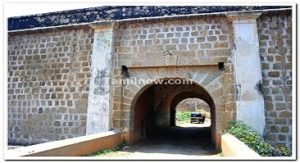 Srirangapatna Fort is a historical fort located in Sringapatna, the historical capital city in the South Indian state of Karnataka. Built by the Timmanna Nayaka in 1454, the fort came to prominence during the rule of Tipu Sultan. The fort was fully fortified and the architecture was modified with the help of French architects to meet the growing needs of saving against invaders. The river Kaveri surrounds the fort in one of the sides. The fort is protected in the West and Northern directions by river Cauvery. The fort had Lal Mahal and Tipu’s palace, which were demolished during the British capture of 1799. There are seven outlets and two dungeons.
Srirangapatna Fort is a historical fort located in Sringapatna, the historical capital city in the South Indian state of Karnataka. Built by the Timmanna Nayaka in 1454, the fort came to prominence during the rule of Tipu Sultan. The fort was fully fortified and the architecture was modified with the help of French architects to meet the growing needs of saving against invaders. The river Kaveri surrounds the fort in one of the sides. The fort is protected in the West and Northern directions by river Cauvery. The fort had Lal Mahal and Tipu’s palace, which were demolished during the British capture of 1799. There are seven outlets and two dungeons.
SRI RANGANATHASWAMY TEMPLE
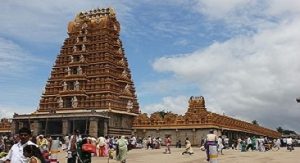 The Ranganthaswamy temple (usually referred to as “Sri Ranganathaswamy”) in Srirangapatna, in the Mandya district of Karnataka state, India, is dedicated to the Hindu god Ranganatha (a manifestation of the god Vishnu). It is one of the five important pilgrimage sites of Sri Vaishnavism along the river Kaveri for devotees of Ranganatha. These five sacred sites are together known as Pancharanga Kshetrams in Southern India. Since Srirangapatna is the first temple starting from upstream, the deity is known as Adi Ranga (lit; “first Ranga”).The town of Srirangapatna, which derives its name from the temple, is located on an island in the river Kaveri.
The Ranganthaswamy temple (usually referred to as “Sri Ranganathaswamy”) in Srirangapatna, in the Mandya district of Karnataka state, India, is dedicated to the Hindu god Ranganatha (a manifestation of the god Vishnu). It is one of the five important pilgrimage sites of Sri Vaishnavism along the river Kaveri for devotees of Ranganatha. These five sacred sites are together known as Pancharanga Kshetrams in Southern India. Since Srirangapatna is the first temple starting from upstream, the deity is known as Adi Ranga (lit; “first Ranga”).The town of Srirangapatna, which derives its name from the temple, is located on an island in the river Kaveri.
DARIA DAULAT BAGH / TIPU SULTAN SUMMER PALACE
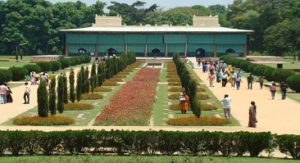 Srirangapatna is an island in the river Kaveri, about 14 km from Mysore. In Srirangapatna is the Dariya Daulat Palace (Summer Palace) that is set amidst beautiful gardens called Daria Daulat Bagh. Tippu Sultan popularly known as the “Tiger of Mysore”, built this palace in 1784 and ruled Mysore from here for a short time after his father Hyder Ali wrested power from the Wodeyars in the middle of the 18th century. The palace is built in the Indo-Sarcenic style in mostly made of teakwood. The palace has a rectangular plan and is built on a raised platform. There are open corridors along the four sides of the platform with wooden pillars at the edges of the Plinth. The western and eastern wings have walls the other two wings have recessed bays with pillars supporting the roof.
Srirangapatna is an island in the river Kaveri, about 14 km from Mysore. In Srirangapatna is the Dariya Daulat Palace (Summer Palace) that is set amidst beautiful gardens called Daria Daulat Bagh. Tippu Sultan popularly known as the “Tiger of Mysore”, built this palace in 1784 and ruled Mysore from here for a short time after his father Hyder Ali wrested power from the Wodeyars in the middle of the 18th century. The palace is built in the Indo-Sarcenic style in mostly made of teakwood. The palace has a rectangular plan and is built on a raised platform. There are open corridors along the four sides of the platform with wooden pillars at the edges of the Plinth. The western and eastern wings have walls the other two wings have recessed bays with pillars supporting the roof.
GAMBAZ
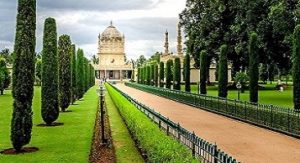 The Gumbaz is designed in the Persian style, with a large rectangle shaped garden, having a path leading to the mausoleum. In the middle of the garden, the Gumbaz stands on an elevated platform. The dome is supported by sharply cut black granite pillars. The doors and windows have lattice work cut through in stone on the same black granite material. The walls inside are painted with tiger stripes, the colours of Tippu Sultan. The three graves of Tippu Sultan, his father Hyder Ali and his mother Fakr-Un-Nisa are located inside the mausoleum. Many of Tippu’s relatives are buried outside the mausoleum in the garden. Most of the grave inscriptions are in Farsi. Next to the Gumbaz is the Masjid-E-Aksa, which was also built by Tippu Sultan
The Gumbaz is designed in the Persian style, with a large rectangle shaped garden, having a path leading to the mausoleum. In the middle of the garden, the Gumbaz stands on an elevated platform. The dome is supported by sharply cut black granite pillars. The doors and windows have lattice work cut through in stone on the same black granite material. The walls inside are painted with tiger stripes, the colours of Tippu Sultan. The three graves of Tippu Sultan, his father Hyder Ali and his mother Fakr-Un-Nisa are located inside the mausoleum. Many of Tippu’s relatives are buried outside the mausoleum in the garden. Most of the grave inscriptions are in Farsi. Next to the Gumbaz is the Masjid-E-Aksa, which was also built by Tippu Sultan
TRIVENI SANGAMA
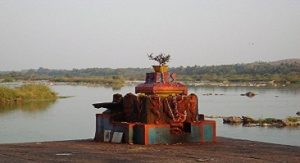 ‘Triveni Sangam is the “confluence” of three rivers We undertake all types of ritual services like asthi visarjane,aparakarma,narayanbhali,thilahoma,pretha samsara,pinda pradhana Sangam, located near a temple, is the confluence of three rivers. At this point, other branch of the River Cauvery, Loakpavani is reunited. … River Cauvery flows into the Mettur Dam in Tamil Nadu, from the point of confluence. It is the meeting point of Kabini River, Hemavati River and River Cauvery.
‘Triveni Sangam is the “confluence” of three rivers We undertake all types of ritual services like asthi visarjane,aparakarma,narayanbhali,thilahoma,pretha samsara,pinda pradhana Sangam, located near a temple, is the confluence of three rivers. At this point, other branch of the River Cauvery, Loakpavani is reunited. … River Cauvery flows into the Mettur Dam in Tamil Nadu, from the point of confluence. It is the meeting point of Kabini River, Hemavati River and River Cauvery.
RANGANATHITTU BIRD SANCTUARY
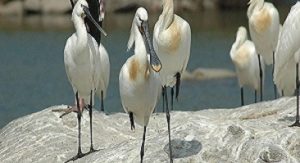 Ranganathittu Bird Sanctuary, also known as Pakshi Kashi of Karnataka, is a bird sanctuary in the Mandya District of the state of Karnataka in India.It is the largest bird sanctuary in the state,only 40 acres (16 ha) in area,and comprises six islets on the banks of the Kaveri river. Ranganathittu is located three kilometers away from the historic town of Sringapatna and 16 kilometres (9.9 mi) north of Mysore.The sanctuary attracted about 3 lakh visitors during 2016–17, which shows its notability as important bird sanctuary of India.During winter months, starting from mid-December, as many as 40,000 birds congregate in this bird sanctuary. Of which, some birds come from Siberia, Latin America and parts of north India. Ranganathittu is a popular nesting site for the birds and about 8,000 nestlings were sighted during June 2011.
Ranganathittu Bird Sanctuary, also known as Pakshi Kashi of Karnataka, is a bird sanctuary in the Mandya District of the state of Karnataka in India.It is the largest bird sanctuary in the state,only 40 acres (16 ha) in area,and comprises six islets on the banks of the Kaveri river. Ranganathittu is located three kilometers away from the historic town of Sringapatna and 16 kilometres (9.9 mi) north of Mysore.The sanctuary attracted about 3 lakh visitors during 2016–17, which shows its notability as important bird sanctuary of India.During winter months, starting from mid-December, as many as 40,000 birds congregate in this bird sanctuary. Of which, some birds come from Siberia, Latin America and parts of north India. Ranganathittu is a popular nesting site for the birds and about 8,000 nestlings were sighted during June 2011.
BRINDAVAN GARDENS
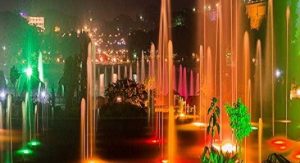 Brindavan Gardens is a famous & beautiful garden laid out below the Krishnaraja Sagar Dam. The construction work of the garden was started in the year 1927 and completed in 1932. This is one of the best tourist places to visit in Mysore.The garden was designed by Sir Mirza Ismail, Diwan of Mysore based on Shalimar Gardens of Kashmir in the Mughal style. Spread over an area of 150 acres, the Brindavan Gardens is considered as one of the best gardens in India. The garden is enriched with fountains, terraces, parterres, running and cascading water channels, lush green lawns & flower beds.The Musical and dancing fountain, located in the North Brindavan Garden, is the main attraction of the garden. The best time to visit the gardens is after sunset when all the bright colourful fountains come alive. The garden also has a wonderful palace in southern park which is now converted to a 4-star luxery hotel called Royal Orchid.
Brindavan Gardens is a famous & beautiful garden laid out below the Krishnaraja Sagar Dam. The construction work of the garden was started in the year 1927 and completed in 1932. This is one of the best tourist places to visit in Mysore.The garden was designed by Sir Mirza Ismail, Diwan of Mysore based on Shalimar Gardens of Kashmir in the Mughal style. Spread over an area of 150 acres, the Brindavan Gardens is considered as one of the best gardens in India. The garden is enriched with fountains, terraces, parterres, running and cascading water channels, lush green lawns & flower beds.The Musical and dancing fountain, located in the North Brindavan Garden, is the main attraction of the garden. The best time to visit the gardens is after sunset when all the bright colourful fountains come alive. The garden also has a wonderful palace in southern park which is now converted to a 4-star luxery hotel called Royal Orchid.
Drop at Mysore Hotel / Airport / Railway Station / Bus Station. End of a 4 days Best Of Mysore Local Sightseeing Tour
[Four Days Tour Car Rental Tariffs]
| Sl.No. | Cab Type | Per Day Non Ac | Per Day A/c | Add Km | Add Hrs | Parking Extra |
| 1 | Indica | Rs 1,400/- | Rs 1,600/- | Rs 08/- | Rs 150/- | Yes |
| 2 | Toyota Etios | Rs 1,800/- | Rs 2,100/- | Rs 10/- | Rs 200/- | Yes |
| 3 | Tavera | Rs 2,100/- | Rs 2,400/- | Rs 12/- | Rs 250/- | Yes |
| 4 | Innova | Rs 2,600/- | Rs 2,900/- | Rs 14/- | Rs 300/- | Yes |
| 5 | Tempo Traveller 12 + 1 Seater | Rs 4,200/- | Rs 4,600/- | Rs 16/- | Rs 400/- | Yes |
| 6 | Mini Bus 20 + 1 seater | Rs 5,200/- | Rs 5,600/- | Rs 26/- | Rs 400/- | Yes |
Guests are requested to follow the itinerary provided in the 4 Days Best Of Mysore Local Sightseeing tour package. This 4 days Karnataka tour package can not be customized, however if guests prefer to visit different set of places in Karnataka and around, they can create their own itinerary and request for a custom quote from cab providers.
